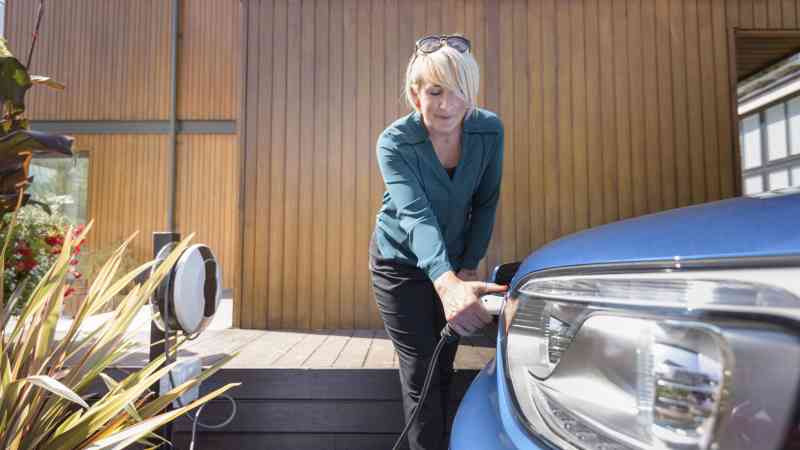If you want to take advantage of the £350 government grant, cutting the cost of installing an EV charger at homes by about a third, you’d better get your skates on because it closes on March 31.
Smart Home Energy, a supply and installation company, says its cut-off date for applications under the grant scheme is February 18. And British Gas, which installs domestic charging points in partnership with the RAC and Hive, says: “Anyone requiring electrical upgrades [for a home charging point] will face an uphill battle to get the installation completed before the end of March deadline. This requires consent from the DNOs [district network operators supplying electricity] and other utilities and this process is taking six weeks or more.”
The Electric Vehicle Home Charge Scheme (EVHS), launched in 2010, is being scaled back, despite electric vehicle sales breaking all records and the RAC saying that an estimated 80 per cent of electric car charging takes place at home. EVHS will remain open beyond March for owners and tenants of flats with off-street parking.
It is possible to charge hybrid cars from a three-pin socket at home with the relevant leads provided by the manufacturer, however Danny Morgan of Smart Home Charge says installing a EV charger will make charging faster and potentially safer. “It’s possible to charge a hybrid such as the Porsche Cayenne on a domestic socket because hybrids have a smaller battery than a full EV. However, it is more prudent to have a dedicated charge point. Charging can overwhelm an ordinary socket. Also, fitting a charger is good future-proofing. People who buy a plug-in hybrid, eventually you’re going to move on to electric,” he says.
How to buy and installThere is nothing to stop you buying your own home EV charger and asking a qualified electrician to fit it for you. However, installing a charging point is not like adding an extra plug socket to your shed. It’s a complex operation involving high currents and advanced earthing and bonding, with specific regulations to follow. “A lot of these chargers work with an app, like a boiler with a smart home system,” says Danny Morgan, the editor of the Smart Home Charge website. “Not all electricians know how to do that kind of syncing up.”
If you are taking advantage of the EVHS funding, also known as the OZEV (Office for Zero Emission Vehicles) grant, you need the installer to apply for it on your behalf. EVs must also be on the government-approved list to qualify for funding.
Tethered or untethered?There are two types of EV home charging point, tethered and untethered. A tethered charger has an attached cable. It’s more convenient and secure. You just uncoil it and plug it in and it can’t be removed from the charging unit. However, there is a limited choice of cable lengths (typically 5 metres) and it will be restricted to charging a certain EV (Type 1 or Type 2). So if visitors want to borrow your charger and it’s not compatible, they’re out of luck. With an untethered charger you need a separate cable, which is usually stashed away in the boot of the car. However, there are now combined tethered/untethered chargers shaking up the market that provide both options, such as the Easee One, from £629 with EVHS grant.
CostsThis will vary depending on the type of charging point, the design and spec and electrical work required. As an example, British Gas quotes the cost of an Alfen Eve S-Line tethered EV charging point installation benefitting from the £350 government grant, from £684. The untethered Alfen Eve S-Line would be from £599, installed. From April 2022 the Alfen S-Line tethered will be from £1,034 and the S-Line untethered from £949.
What’s the wait time?British Gas offers a virtual survey to assess the suitability of your home and electrical set-up for a charger. These are usually carried out within ten days of order. It says installations can take as little as 14 days and average about a month.
It could take longer if you need to have your fuse box/consumer unit upgraded, if your home needs to be “de-looped” from neighbouring properties before installation and your electricity supply requires an earth rod or your DNO insists on installing a new electricity meter before installation. Find your DNO here: energynetworks.org
Save money on charging billsCharging your car at home is convenient, but it will cost. The average-mileage UK motorist can expect their electricity meter to clock between 50 and 80 per cent more power usage when charging a car, says the motoring magazine Auto Express.
A number of energy providers offer EV-friendly home energy tariffs designed to help motorists make the most of off-peak hours. As of November 2021, Auto Express found Octopus, EDF and British Gas the most economical EV energy providers.
Know your chargersA dedicated home charger (7.4kw) — the typical home charge point will add about 30 miles per hour. A 7.4kw charger is recommended by Smart Home Charge — this is more than fast enough for most drivers as you will usually “top up” your battery for a few hours overnight.
A dedicated three-phase home charger (up to 22kw) — capable of adding about 50 to 60 miles an hour. However, most residential properties cannot support these chargers and most EV drivers won’t really benefit from them.
Source: Smart Home Charge
